Making authentic Mexican chili con carne is easy, and this Tex-Mex dish will be a regular in your rotation. We at gaymexico.net, understand that culinary exploration is a delightful way to connect with Mexican culture, especially for the LGBTQ+ community. This guide provides a flavorful journey, ensuring your chili con carne is both authentic and delicious.
Explore the heart of Mexico through its vibrant cuisine and LGBTQ+ scene on gaymexico.net, where tradition meets acceptance in a celebration of culture and community. Discover LGBTQ+ friendly destinations and events, making your Mexican adventure unforgettable.
1. What Ingredients Do I Need To Make Authentic Mexican Chili Con Carne?
Authentic Mexican chili con carne requires dried chiles, beef chuck, tomatoes, onions, garlic, and spices like Mexican oregano and cumin. The use of dried chiles is key to achieving a deep, complex flavor that is characteristic of authentic chili.
Here’s a detailed list of ingredients:
- Beef: 2-2.5 lbs chuck roast, cut into 1-1.5″ chunks
- Dried Chiles: 3 Ancho and 3 Guajillo dried chiles (or a mix of your choice)
- Aromatics: 1 onion, finely chopped, 4 garlic cloves, minced
- Tomatoes: 3-4 Roma tomatoes, roasted
- Optional Heat: 1 chipotle in adobo
- Beans (Optional): 1-2 cans (15oz each) of black beans, pinto beans, or kidney beans
- Stock: 5 cups of beef or chicken stock
- Spices: 1 tablespoon Mexican oregano, 1/2 teaspoon cumin, 1 teaspoon salt (plus more to taste), freshly cracked black pepper
- Oil: For searing the beef and sautéing vegetables
The choice of ingredients allows for customization, ensuring that the final dish caters to individual preferences while maintaining its authentic essence.
2. How To Prepare The Dried Chiles For Mexican Chili Con Carne?
To prepare dried chiles, remove the stems and seeds, then roast them briefly in the oven to enhance their flavor. After roasting, rehydrate the chiles by soaking them in hot water for about 20-30 minutes.
This process unlocks the chiles’ rich flavors and ensures they blend smoothly into the chili. Here’s a step-by-step guide:
- Clean the Chiles: Wipe off any dust or debris from the dried chiles.
- Remove Stems and Seeds: De-stem and de-seed the chiles. While it’s important to remove most of the seeds, don’t worry about getting rid of every last one.
- Roast the Chiles: Place the chiles on a baking sheet and roast them in a 400°F (200°C) oven for 1-2 minutes. Keep a close eye on them to prevent burning, which can make them bitter. The chiles should become fragrant and slightly pliable.
- Rehydrate the Chiles: Transfer the roasted chiles to a bowl and cover them with hot tap water. Let them soak for 20-30 minutes, or until they are soft and pliable. You can use a small bowl or plate to keep them submerged if they float to the top.
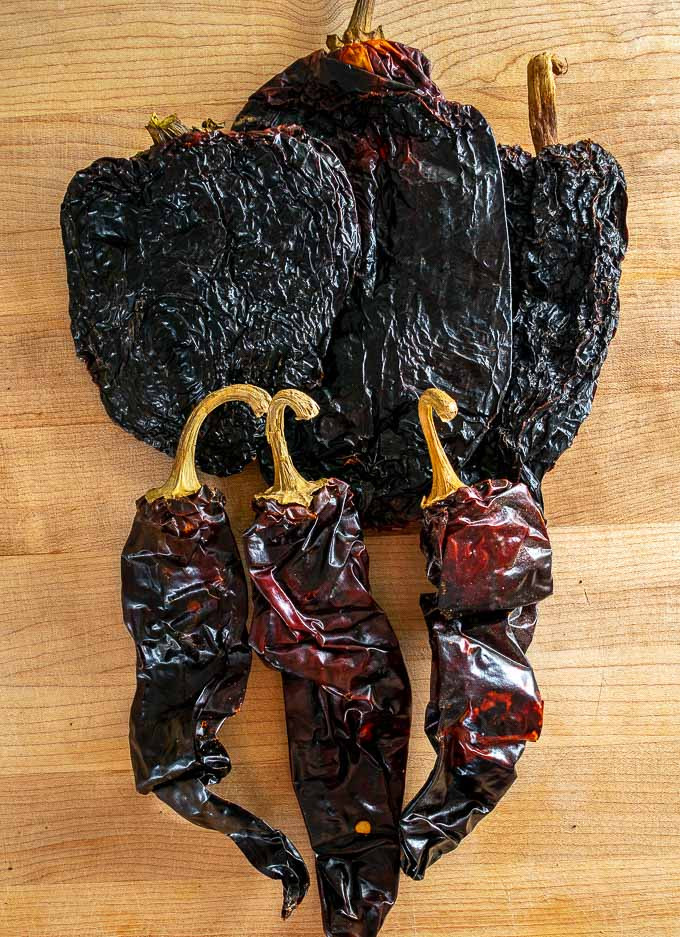 Ancho and Guajillo dried chiles for Chili con Carne
Ancho and Guajillo dried chiles for Chili con Carne
3. What Is The Best Cut Of Beef To Use For Chili Con Carne?
Chuck roast is the best cut of beef for chili con carne, as it becomes tender and flavorful during the long simmering process. Chuck roast has a good amount of marbling, which renders down during cooking, adding richness to the chili.
Other suitable cuts include:
- Brisket: Known for its rich flavor and tenderness when slow-cooked.
- Short Ribs: Adds a deep, beefy flavor and fall-off-the-bone tenderness.
- Stew Meat: Often a mix of tougher cuts that become tender with long cooking times.
4. How Do You Sear The Beef For Chili Con Carne?
To sear the beef for chili con carne, heat a soup pot or Dutch oven over medium-high heat with oil. Sear the beef chunks in batches to avoid overcrowding the pot, ensuring each piece develops a rich, brown crust on all sides.
Searing the beef adds a depth of flavor to the chili through the Maillard reaction, which creates complex flavors and aromas. Follow these steps for the best results:
- Prepare the Beef: Cut the chuck roast into 1-1.5 inch chunks and season generously with salt.
- Heat the Pot: Preheat a soup pot or Dutch oven over medium-high heat. Add a tablespoon or two of oil, enough to coat the bottom of the pot.
- Sear in Batches: Add the beef chunks to the hot pot in a single layer, making sure not to overcrowd the pot. Overcrowding will lower the temperature and cause the beef to steam instead of sear.
- Sear on All Sides: Let the beef sear for 2-3 minutes per side, until a rich brown crust forms. Use tongs to turn the pieces and sear on all sides.
- Set Aside: Once the beef is browned, remove it from the pot and set it aside.
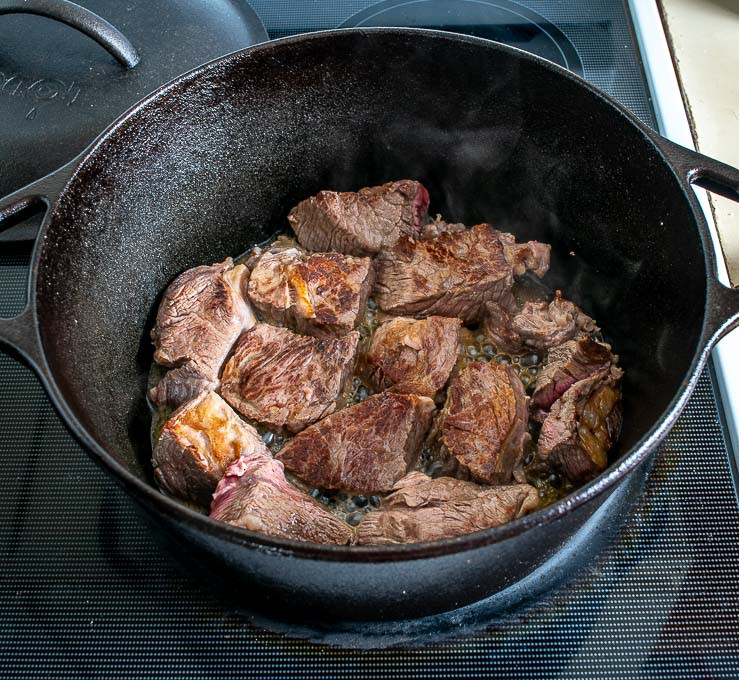 Searing beef pieces in Lodge cast iron Dutch oven
Searing beef pieces in Lodge cast iron Dutch oven
5. What Is The Best Way To Roast Tomatoes For Chili Con Carne?
Roasting tomatoes enhances their sweetness and adds depth to the chili. Simply place Roma tomatoes in a 400°F (200°C) oven for 20-30 minutes, or until their skins are blistered and slightly charred.
Here’s a detailed guide:
- Prepare the Tomatoes: Rinse the Roma tomatoes and remove the stems. You can also make a small X on the bottom of each tomato to help the skin peel off more easily after roasting.
- Roast the Tomatoes: Place the tomatoes on a baking sheet and roast them in a 400°F (200°C) oven for 20-30 minutes. The tomatoes should be soft and their skins should be blistered and slightly charred.
- Cool and Peel (Optional): Once the tomatoes are cool enough to handle, you can peel off the skins if desired. The skins should slip off easily.
6. How To Make The Chile Puree For Chili Con Carne?
To make the chile puree, blend the rehydrated chiles with roasted tomatoes, garlic, onion, and a cup of stock or soaking liquid. This puree forms the base of the chili’s flavor, providing a rich and complex taste.
Follow these steps to create a flavorful chile puree:
- Combine Ingredients: In a blender, combine the rehydrated chiles, roasted tomatoes, half of the sautéed onion-garlic mixture, and the optional chipotle in adobo.
- Add Liquid: Add a cup of stock or the soaking liquid from the chiles to the blender. Taste the soaking liquid first; if it tastes bitter, use stock instead.
- Blend Until Smooth: Blend the mixture until it is smooth and creamy. Add more liquid if needed to achieve a smooth consistency.
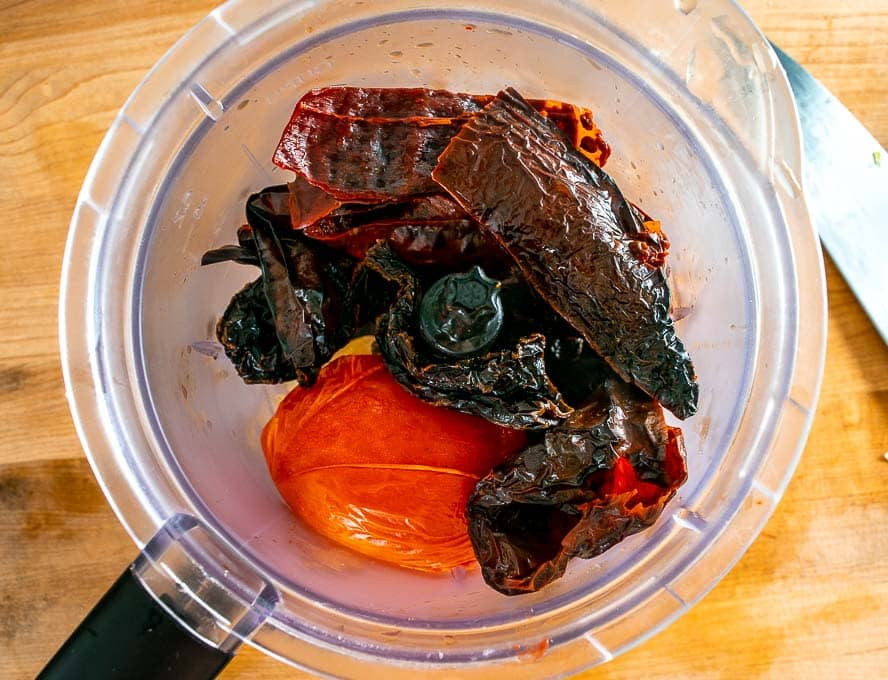 Chile puree before blending
Chile puree before blending
7. What Spices Are Essential For Authentic Chili Con Carne?
Essential spices for authentic chili con carne include Mexican oregano, cumin, salt, and freshly cracked black pepper. These spices enhance the chili’s flavor, providing warmth and depth.
- Mexican Oregano: This has a slightly different flavor profile than Mediterranean oregano, with notes of citrus and anise.
- Cumin: Adds warmth and earthiness to the chili.
- Salt: Enhances the flavors of all the other ingredients.
- Black Pepper: Provides a subtle heat and depth.
8. How Long Should Chili Con Carne Simmer?
Chili con carne should simmer for 1.5-2 hours, or until the beef is tender. Simmering allows the flavors to meld together, creating a rich and complex dish.
During the simmering process:
- Cover the Pot: Cover the pot to trap heat and moisture, which helps to tenderize the beef.
- Maintain Low Heat: Keep the heat on low to medium-low to maintain a gentle simmer. Avoid boiling, which can make the beef tough.
- Check for Tenderness: Check the beef for tenderness after 1.5 hours. If it’s not tender, continue simmering for another 30 minutes to an hour.
9. Should I Add Beans To My Chili Con Carne?
Adding beans to chili con carne is optional. While some purists argue against beans, others enjoy the added texture and flavor. Black beans, pinto beans, or kidney beans are all suitable choices.
If you choose to add beans:
- When to Add: Add the beans towards the end of the simmering process, about 30 minutes before serving. This prevents them from becoming mushy.
- Type of Beans: Black beans, pinto beans, or kidney beans are all good options. Use canned beans for convenience, or cook dried beans from scratch for a more authentic flavor.
- Amount of Beans: Use 1-2 cans (15 oz each) of beans, depending on your preference.
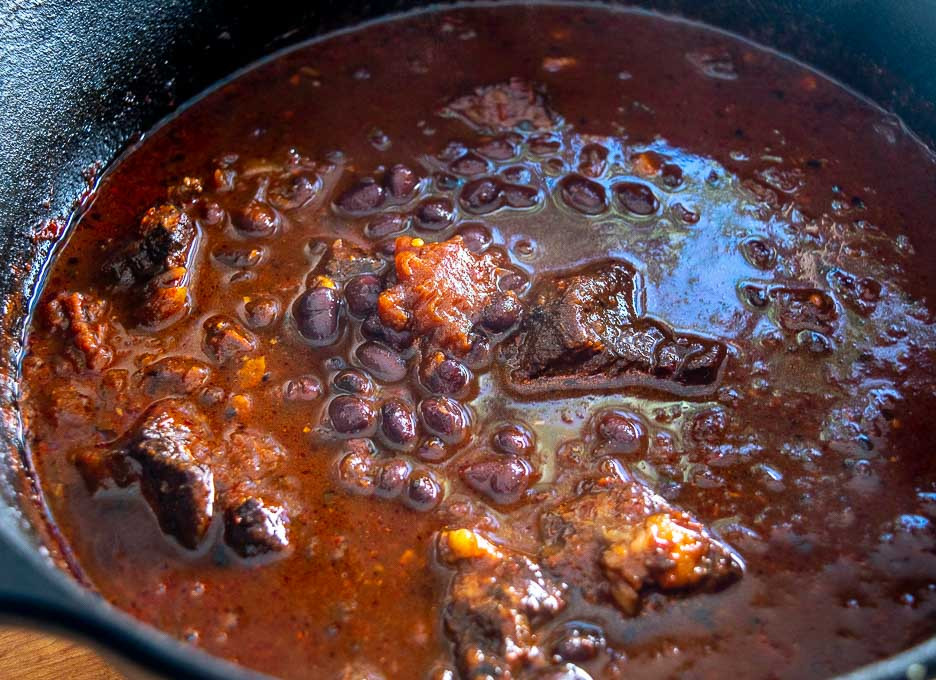 Chili con Carne after adding black beans
Chili con Carne after adding black beans
10. How To Adjust The Consistency Of Chili Con Carne?
To adjust the consistency of chili con carne, add more stock to thin it out or use a cornstarch slurry to thicken it. A cornstarch slurry is made by whisking together cornstarch and cold water before adding it to the chili.
Follow these guidelines to achieve your desired consistency:
- To Thin the Chili: If the chili is too thick, add 1-2 cups of stock and stir well. Allow the chili to simmer for a few more minutes to incorporate the stock.
- To Thicken the Chili: If the chili is too thin, use a cornstarch slurry. In a small bowl, whisk together a few tablespoons of cornstarch with an equal amount of cold water until smooth. Pour the slurry into the chili and stir well. Bring the chili to a simmer and cook for a few minutes until it thickens.
11. What Are Some Popular Garnishes For Chili Con Carne?
Popular garnishes for chili con carne include Mexican crema, freshly chopped cilantro, a squeeze of lime, and crispy tortilla strips. These garnishes add flavor, texture, and visual appeal to the dish.
Here are some other garnish ideas:
- Shredded Cheese: Cheddar, Monterey Jack, or cotija cheese
- Diced Onions: White or red onions
- Avocado: Diced or sliced avocado adds creaminess
- Sour Cream: A dollop of sour cream adds tanginess
- Jalapeños: Sliced or pickled jalapeños for extra heat
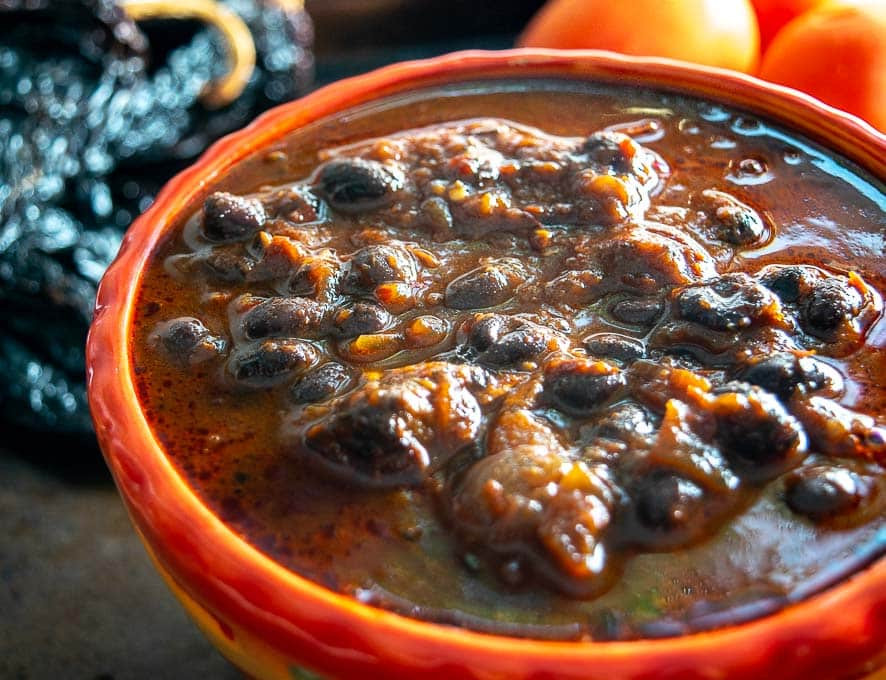 Close-up of bowl of Chili con Carne
Close-up of bowl of Chili con Carne
12. Can I Make Chili Con Carne In A Slow Cooker?
Yes, you can make chili con carne in a slow cooker. Sear the beef and sauté the vegetables as directed, then transfer everything to the slow cooker and cook on low for 6-8 hours or on high for 3-4 hours.
Here’s a step-by-step guide:
- Sear the Beef: Sear the beef chunks in a skillet over medium-high heat until browned on all sides.
- Sauté Vegetables: In the same skillet, sauté the onion and garlic until softened.
- Combine Ingredients: Transfer the seared beef, sautéed vegetables, rehydrated chiles, roasted tomatoes, spices, and stock to the slow cooker.
- Cook: Cook on low for 6-8 hours or on high for 3-4 hours, or until the beef is tender.
- Add Beans (Optional): Add the beans during the last hour of cooking.
13. How To Store Leftover Chili Con Carne?
Store leftover chili con carne in an airtight container in the refrigerator for up to 3-4 days. You can also freeze it for longer storage, up to 2-3 months.
To store leftover chili:
- Cool Completely: Allow the chili to cool completely before storing it.
- Airtight Container: Transfer the chili to an airtight container.
- Refrigerate: Store the chili in the refrigerator for up to 3-4 days.
- Freeze: For longer storage, transfer the chili to a freezer-safe container and freeze for up to 2-3 months. Thaw it in the refrigerator overnight before reheating.
14. What To Serve With Chili Con Carne?
Chili con carne can be served with a variety of sides, such as cornbread, rice, or a simple salad. These sides complement the rich and hearty flavor of the chili.
Other serving suggestions include:
- Cornbread: A classic pairing
- Rice: White or brown rice
- Salad: A simple green salad
- Tortillas: Warm tortillas for scooping or making chili-filled tacos
- Toppings Bar: Set up a toppings bar with various garnishes for guests to customize their chili
15. Can I Make Vegetarian Chili Using This Recipe?
Yes, you can adapt this recipe to make vegetarian chili. Replace the beef with plant-based protein like lentils, beans, or crumbled tofu, and use vegetable stock instead of beef stock.
Here are some tips for making vegetarian chili:
- Plant-Based Protein: Use lentils, beans, or crumbled tofu as a substitute for the beef.
- Vegetable Stock: Use vegetable stock instead of beef stock.
- Add More Vegetables: Add more vegetables like bell peppers, corn, or zucchini to add flavor and texture.
- Adjust Seasoning: Adjust the seasoning as needed to enhance the flavors of the vegetables.
16. What Are Some Variations Of Chili Con Carne?
Variations of chili con carne include adding different types of chiles, using ground beef instead of chuck roast, or incorporating other vegetables like bell peppers or corn. These variations allow for customization based on personal preference and available ingredients.
Some popular variations include:
- Texas Chili: A classic chili made with beef, chiles, and spices, without beans or tomatoes.
- White Chicken Chili: Made with chicken, white beans, and green chiles.
- Vegetarian Chili: Made with plant-based protein and a variety of vegetables.
- Chili Verde: Made with pork and green chiles.
17. How To Make Chili Con Carne Spicier?
To make chili con carne spicier, add more chipotle peppers in adobo, use hotter varieties of dried chiles, or include a pinch of cayenne pepper. Adjust the amount of heat to your preference.
Here are some tips for adding heat:
- Chipotle Peppers in Adobo: Add more chipotle peppers in adobo for a smoky heat.
- Hotter Dried Chiles: Use hotter varieties of dried chiles, such as chile de árbol or piquín chiles.
- Cayenne Pepper: Add a pinch of cayenne pepper for a quick and easy way to add heat.
- Jalapeños: Add sliced or diced jalapeños for a fresh, spicy kick.
18. How To Reduce The Acidity In Chili Con Carne?
To reduce the acidity in chili con carne, add a pinch of sugar or a tablespoon of baking soda. These ingredients help to balance the flavors and reduce the overall acidity of the dish.
Here are some tips for reducing acidity:
- Sugar: Add a pinch of sugar to balance the flavors.
- Baking Soda: Add a tablespoon of baking soda to neutralize the acidity. Be careful not to add too much, as it can affect the flavor.
- Dairy: Add a dollop of sour cream or Mexican crema to balance the acidity.
19. What Are The Nutritional Benefits Of Chili Con Carne?
Chili con carne is a good source of protein, fiber, and essential vitamins and minerals. The beef provides protein and iron, while the beans and vegetables offer fiber and various vitamins.
Here are some of the nutritional benefits of chili con carne:
- Protein: Provides essential amino acids for building and repairing tissues.
- Fiber: Promotes digestive health and helps regulate blood sugar levels.
- Iron: Essential for carrying oxygen in the blood.
- Vitamins and Minerals: Provides various vitamins and minerals, such as vitamin A, vitamin C, and potassium.
20. Can I Make Chili Con Carne In An Instant Pot?
Yes, you can make chili con carne in an Instant Pot. Sear the beef and sauté the vegetables using the sauté function, then add the remaining ingredients and cook on high pressure for 25-30 minutes, followed by a natural pressure release.
Here’s a step-by-step guide:
- Sauté Beef: Use the sauté function to sear the beef chunks until browned on all sides.
- Sauté Vegetables: Add the onion and garlic to the Instant Pot and sauté until softened.
- Add Remaining Ingredients: Add the rehydrated chiles, roasted tomatoes, spices, and stock to the Instant Pot.
- Cook: Cook on high pressure for 25-30 minutes, followed by a natural pressure release.
- Add Beans (Optional): Add the beans after the pressure is released and simmer for a few minutes.
21. What Makes Chili Con Carne An Authentic Mexican Dish?
Chili con carne’s authenticity lies in its use of dried chiles and simple, hearty ingredients. While its origins are Tex-Mex, the dish draws inspiration from traditional Mexican flavors and cooking techniques.
Key elements of authentic chili con carne include:
- Dried Chiles: The use of dried chiles is essential for achieving a deep, complex flavor.
- Simple Ingredients: The dish is made with simple, hearty ingredients like beef, tomatoes, onions, garlic, and spices.
- Slow Cooking: Slow cooking allows the flavors to meld together, creating a rich and satisfying dish.
22. What Are Some Common Mistakes To Avoid When Making Chili Con Carne?
Common mistakes to avoid when making chili con carne include burning the chiles, overcrowding the pot when searing the beef, and not simmering the chili long enough. Avoiding these mistakes will result in a more flavorful and well-cooked dish.
Here are some common mistakes to avoid:
- Burning the Chiles: Keep a close eye on the chiles when roasting them to prevent burning, which can make them bitter.
- Overcrowding the Pot: Sear the beef in batches to avoid overcrowding the pot, which can cause the beef to steam instead of sear.
- Not Simmering Long Enough: Simmer the chili for at least 1.5-2 hours to allow the flavors to meld together and the beef to become tender.
23. How Do I Choose The Right Dried Chiles For My Taste Preference?
Choosing the right dried chiles depends on your taste preference for heat and flavor. Ancho chiles offer a mild, fruity flavor, while guajillo chiles provide a moderate heat and slightly tangy taste. For more heat, consider using chile de árbol or piquín chiles.
Here’s a guide to different types of dried chiles:
- Ancho Chiles: Mild heat with a fruity, slightly sweet flavor.
- Guajillo Chiles: Moderate heat with a slightly tangy, fruity flavor.
- Chile de Árbol: High heat with a smoky flavor.
- Piquín Chiles: Very high heat with a fruity, nutty flavor.
24. What Are The Best Stocks To Use For Chili Con Carne?
The best stocks to use for chili con carne are beef stock or chicken stock. These stocks add depth and richness to the dish, enhancing the overall flavor.
Here are some tips for choosing the right stock:
- Beef Stock: Adds a rich, beefy flavor that complements the beef in the chili.
- Chicken Stock: Adds a lighter, more subtle flavor that balances the richness of the beef.
- Homemade Stock: Homemade stock is always the best option, as it has a more complex flavor and no added salt or preservatives.
25. How Can I Make Chili Con Carne Healthier?
You can make chili con carne healthier by using lean beef, adding more vegetables, and reducing the amount of salt and fat. These adjustments will lower the calorie and fat content while increasing the nutrient density of the dish.
Here are some tips for making chili healthier:
- Lean Beef: Use lean beef to reduce the fat content.
- More Vegetables: Add more vegetables like bell peppers, corn, or zucchini to increase the fiber and nutrient content.
- Reduce Salt: Reduce the amount of salt used in the recipe.
- Healthy Fats: Use olive oil instead of other oils or fats.
26. What Cultural Significance Does Chili Con Carne Hold?
Chili con carne holds cultural significance as a Tex-Mex dish that represents the fusion of Mexican and American culinary traditions. It is often associated with comfort food and is a staple in many households and restaurants.
Here are some key points about its cultural significance:
- Tex-Mex Cuisine: Chili con carne is a prime example of Tex-Mex cuisine, which blends Mexican and American flavors and cooking techniques.
- Comfort Food: It is often considered comfort food, enjoyed during cold weather or as a hearty meal.
- Regional Variations: There are many regional variations of chili con carne, reflecting the diverse culinary traditions of different communities.
27. Are There Any Specific Regional Variations Of Chili Con Carne In Mexico?
While chili con carne is more commonly associated with Tex-Mex cuisine, there are regional variations in Mexico that share similarities. These variations often incorporate local ingredients and flavors, reflecting the diverse culinary traditions of different regions.
Some examples include:
- Chilis with Mole: In some regions, chili is prepared with mole sauce, adding a rich, complex flavor.
- Use of Local Chiles: Different regions may use different types of local chiles to create unique flavor profiles.
- Vegetarian Options: Vegetarian versions of chili are also common, using beans, vegetables, and spices to create a hearty and flavorful dish.
28. How To Serve Chili Con Carne At A Party?
To serve chili con carne at a party, set up a chili bar with various toppings and sides. Keep the chili warm in a slow cooker or chafing dish, and provide ladles and serving spoons for easy access.
Here are some tips for serving chili at a party:
- Chili Bar: Set up a chili bar with various toppings like shredded cheese, sour cream, diced onions, jalapeños, and cilantro.
- Sides: Provide sides like cornbread, rice, and tortillas.
- Keep Warm: Keep the chili warm in a slow cooker or chafing dish.
- Serving Utensils: Provide ladles and serving spoons for easy access.
29. What Drinks Pair Well With Chili Con Carne?
Drinks that pair well with chili con carne include beer, margaritas, and red wine. The bold and spicy flavors of the chili complement these beverages, creating a satisfying culinary experience.
Here are some specific drink pairings:
- Beer: A cold, crisp beer like a Mexican lager or an IPA.
- Margaritas: The tangy and refreshing flavors of a margarita.
- Red Wine: A medium-bodied red wine like a Merlot or a Malbec.
30. What Safety Precautions Should I Take When Cooking With Dried Chiles?
When cooking with dried chiles, wear gloves to avoid skin irritation and avoid touching your eyes. Be mindful of the fumes when roasting the chiles, as they can be potent.
Here are some safety tips:
- Wear Gloves: Wear gloves to avoid skin irritation when handling dried chiles.
- Avoid Touching Eyes: Avoid touching your eyes after handling dried chiles.
- Ventilation: Ensure good ventilation when roasting the chiles to avoid inhaling the fumes.
- Wash Hands: Wash your hands thoroughly after handling dried chiles.
Making authentic Mexican chili con carne is a rewarding culinary experience, bringing the vibrant flavors of Mexico into your kitchen. Remember, gaymexico.net is your go-to resource for exploring Mexico’s rich culture and LGBTQ+ scene.
Ready to explore more of Mexico? Visit gaymexico.net for travel guides, event listings, and community connections. Whether you’re planning a trip or seeking cultural insights, we’re here to help you discover the best of Mexico.
Address: 3255 Wilshire Blvd, Los Angeles, CA 90010, United States
Phone: +1 (213) 380-2177
Website: gaymexico.net
FAQ About Making Mexican Chili Con Carne
1. Can I use ground beef instead of chuck roast for chili con carne?
Yes, you can use ground beef. Brown the ground beef in the pot before adding the other ingredients. This will result in a quicker cooking time, but the flavor may not be as rich as using chuck roast.
2. How do I prevent my chili from being too watery?
To prevent your chili from being too watery, ensure you don’t add too much stock initially. If it’s already too watery, simmer it uncovered for a longer time to allow some of the liquid to evaporate, or use a cornstarch slurry to thicken it.
3. What if I can’t find Mexican oregano?
If you can’t find Mexican oregano, you can substitute it with regular Mediterranean oregano. However, keep in mind that Mexican oregano has a slightly different flavor profile, so the taste might vary slightly.
4. Can I make chili con carne without roasting the tomatoes?
Yes, you can make chili con carne without roasting the tomatoes, but roasting enhances their sweetness and adds depth to the flavor. If you skip roasting, use canned diced tomatoes or tomato sauce as a substitute.
5. How do I adjust the level of spiciness in my chili?
Adjust the level of spiciness by controlling the amount and type of chiles you use. For a milder chili, use fewer chiles or milder varieties like ancho. For a spicier chili, add more chiles or use hotter varieties like chile de árbol.
6. Is it necessary to remove the seeds from the dried chiles?
Removing the seeds from the dried chiles helps control the level of heat in the chili. If you prefer a milder flavor, remove most of the seeds. If you like it spicier, leave some or all of the seeds in.
7. Can I use a different type of bean in my chili?
Yes, you can use different types of beans such as kidney beans, pinto beans, or cannellini beans. Choose the type of bean that you prefer, or use a combination of different beans for added variety.
8. What’s the best way to reheat chili con carne?
The best way to reheat chili con carne is on the stovetop over medium heat, stirring occasionally. You can also reheat it in the microwave, but make sure to cover it to prevent splattering and stir it periodically for even heating.
9. Can I add beer to my chili con carne recipe?
Yes, adding beer can enhance the flavor of chili con carne. Use a dark beer like a stout or porter, and add it to the pot along with the stock. The beer will add a rich, malty flavor to the chili.
10. How long does chili con carne last in the freezer?
Chili con carne can last in the freezer for up to 2-3 months. Store it in an airtight, freezer-safe container to prevent freezer burn. Thaw it in the refrigerator overnight before reheating.
